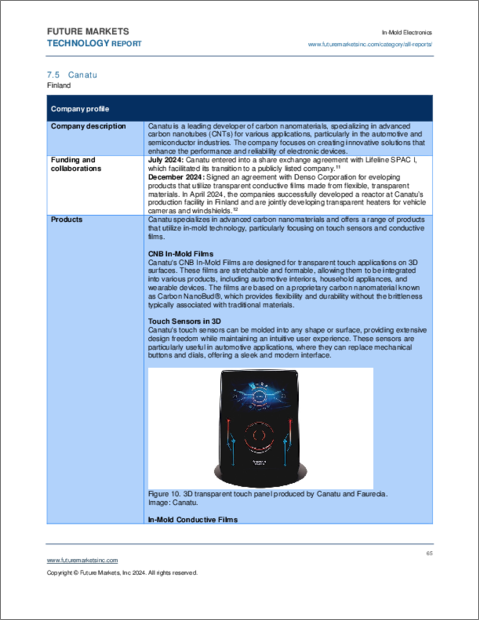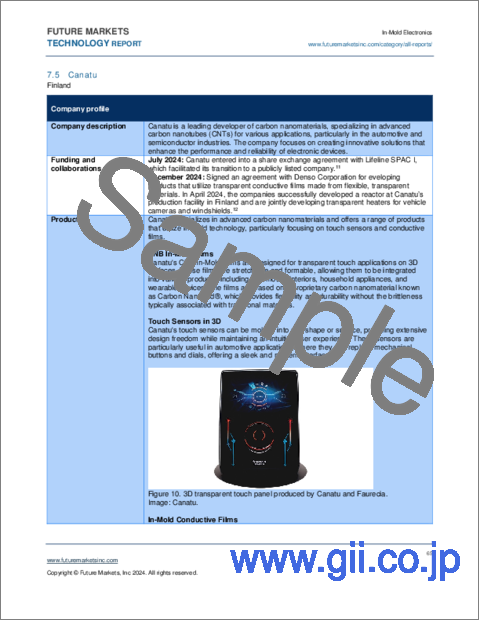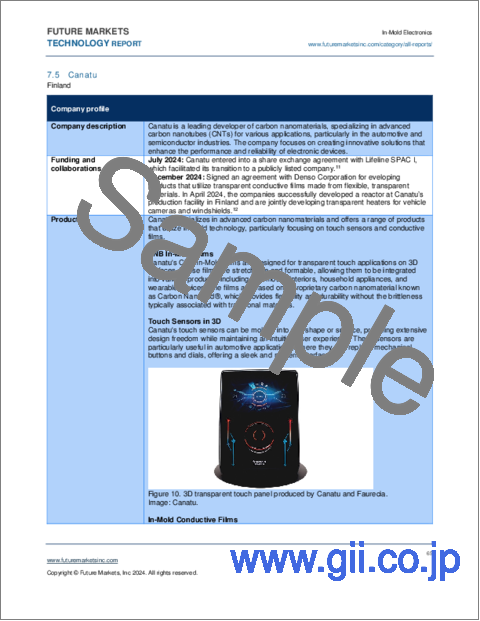|
|
市場調査レポート
商品コード
1628907
インモールドエレクトロニクス(IME)の世界市場(2025年~2035年)The Global Market for In-mold Electronics (IME) 2025-2035 |
||||||
|
|||||||
| インモールドエレクトロニクス(IME)の世界市場(2025年~2035年) |
|
出版日: 2025年01月08日
発行: Future Markets, Inc.
ページ情報: 英文 83 Pages, 47 Tables, 10 Figures
納期: 即納可能
|
全表示
- 概要
- 図表
- 目次
インモールドエレクトロニクス(IME)は、プラストロニクスとも呼ばれ、従来の射出成形とプリンテッドエレクトロニクスを組み合わせた革新的な技術です。このプロセスでは、タッチセンサー、ディスプレイ、照明などの機能的な電子素子を、成形工程でプラスチックコンポーネントに直接埋め込むことができます。このプロセスにより、1回の製造工程でスマートサーフェスと複雑な電子機能を作り出すことができます。IME技術は、タッチセンサー、照明、その他の電子機能を3D成形表面に埋め込むことを可能にし、製造工程の合理化と組立コストの削減をもたらします。これにより、製品の性能が向上するだけでなく、外部コンポーネントが不要になるため外観も向上します。
IMEの利点は以下の通りです。
- 設計の柔軟性:IMEは、従来の電子機器統合手法では不可能だった複雑な形状や設計を可能にします。
- 耐久性:電子部品は成型されたプラスチックの中で保護されるため、摩耗や環境要因に強くなります。
- コスト効率:複数の機能を1つのコンポーネントに統合することで、IMEは組立コストを削減し、製造効率を向上させることができます。
IME技術には、通常3つのステップがあります。
- 電子回路の印刷:このステップでは、導電性インクを塗布して必要な電子回路を形成します。
- 成形:この工程は、電子回路が最終製品にシームレスに収まるようにするために重要です。
- 成形:最後に、成形された回路は成形部品に封入され、自動車の内装、コンシューマーエレクトロニクス、医療機器などのさまざまな用途に使用できる耐久性と機能性に優れた電子部品となります。
IME製品は、省スペースと軽量化が重要な自動車、コンシューマーエレクトロニクス、医療機器などの産業で特に有益です。この技術は、製品設計を向上させるだけでなく、個別の電子部品の組立を不要にすることで耐久性と性能を向上させ、ユーザーフレンドリーなインターフェースや複雑な電子システムを1つの成形部品で実現します。IME製品は、スマートコネクテッドデバイスに対する需要の高まりに対応するよう設計されており、メーカーは競争の激しい市場において製品の革新と差別化を図ることができます。
当レポートでは、急成長する世界のインモールドエレクトロニクス(IME)市場について詳細に分析し、主な動向、技術、材料、用途、2025年~2035年の市場予測などを提供しています。
目次
第1章 エグゼクティブサマリー
- 表面上の設計制限
- 用途
- IME製造
- 投資
- 持続可能性
- 市場見通し
- 市場予測
第2章 イントロダクション
第3章 IME製造
- IMEコンポーネント
- IME生産
- 実装アプローチ
- その他の生産手法
- 機能性フィルム接着
- メタライゼーション手法
- MID技術
- 多機能複合材料
- 付加製造
第4章 IMEコンポーネントの統合
- 静電容量センシング技術
- 照明
- 触覚
- 3Dディスプレイ
- アンテナ
第5章 IME向け材料
- 概要
- 導電性インク
- 誘電性インク
- 導電性接着剤
- 透明導電性材料
- 基板、熱可塑性材料
第6章 IMEの市場
- 自動車
- 概要
- 商業用途
- 世界市場の予測
- 白物家電
- 概要
- 用途
- 世界市場の予測
- 医療機器
- 概要
- 用途
- 世界市場の予測
- 工業
- 概要
- 用途
- ウェアラブルエレクトロニクス
- 概要
- 用途
- その他の市場と用途
第7章 企業プロファイル
第8章 参考文献
List of Tables
- Table 1. Surface Functionalization Technologies Comparison
- Table 2. In-Mold Electronics Applications
- Table 3. IME Manufacturing Requirements
- Table 4. Competing Manufacturing Methods
- Table 5. Smart Surface Manufacturing Methods
- Table 6. Investment in In-Mold Electronics
- Table 7. IME Applications and Stage of Development
- Table 8. IME Benefits and Challenges
- Table 9. Global Market Forecast for IME Component Area by Application, 2025-2035(m2)
- Table 10. Global Market Forecast for IME Revenue by Application, 2025-2035 (US$ Millions)
- Table 11. In-mold Electronics Applications and Markets
- Table 12. Approaches to 3D Printed Electronics
- Table 13. Manufacturing of IME Components
- Table 14. Manufacturing Methods Comparison
- Table 15. IME Production Equipment
- Table 16. IC Package Requirements for IME
- Table 17. Process Comparison
- Table 18. Comparison of Metallization Methods
- Table 19. MID Manufacturing Methods Comparison
- Table 20. Applications of LDS
- Table 21. Applications for Printing Wiring onto 3D Surfaces
- Table 22. Processes for 3D Electronics
- Table 23. Printed Capacitive Sensor Technologies
- Table 24. Conventional Backlighting vs Integrated Lighting with IME
- Table 25. Materials for IME
- Table 26. Material Composition comparison of IME vs Conventional HMI
- Table 27. IME Materials companies
- Table 28. Conductive Ink Materials
- Table 29. In-mold Conductive Inks
- Table 30. Conductive Ink Requirements for IME
- Table 31. Properties of Stretchable/Thermoformable Conductive Inks
- Table 32. Types of Conductive Adhesives
- Table 33. Transparent Conductive Materials for IME
- Table 34. Carbon Nanotube In-mold Films
- Table 35. PEDOT:PSS Films
- Table 36. Substrates and Thermoplastics for IME
- Table 37.IME in Automotive HMI
- Table 38. Commercial Automotive In-mold Decoration
- Table 39. Global market forecast for IME in the Automotive Market 2025-2035 (USD Millions)
- Table 40. Applications of IME in White Goods
- Table 41. Example IME for White Goods products
- Table 42. Global market forecast for IME in White Goods Market 2025-2035 (USD Millions)
- Table 43. Medical Device Applications
- Table 44. Global market forecast for IME in Medical Devices Market 2025-2035 (USD Millions)
- Table 45. Industrial IME Applications
- Table 46. Wearable IME Applications
- Table 47. Other markets and applications for IME
List of Figures
- Figure 1. IME device
- Figure 2. IME manufacturing process flow
- Figure 3. Global Market Forecast for IME Component Area by Application, 2025-2035 (m2)
- Figure 4. Global Market Forecast for IME Revenue by Application, 2025-2035 (US$ Millions)
- Figure 5. IME Value Chain
- Figure 6. Global market forecast for IME in the Automotive Market 2025-2035 (USD Millions)
- Figure 7. Top panel of the remote control, made with in-mold decoration (IMD)
- Figure 8. Global market forecast for IME in White Goods Market 2025-2035 (USD Millions)
- Figure 9. Global market forecast for IME in Medical Devices Market 2025-2035 (USD Millions)
- Figure 10. Origo Steering Wheel
In-mold electronics (IME), also sometimes known as plastronics, is an innovative technology that combines traditional injection molding with printed electronics. This process allows for the embedding of functional electronic elements, such as touch sensors, displays, and lighting, directly into plastic components during the molding process. This process allows for the creation of smart surfaces and complex electronic functionalities within a single manufacturing step. IME technology enables the embedding of touch sensors, lighting, and other electronic functionalities into 3D molded surfaces, resulting in streamlined manufacturing processes and reduced assembly costs. This not only enhances product performance but also improves aesthetics by removing the need for external components.
The advantages of IME include:
- Design Flexibility: IME enables the creation of complex shapes and designs that are not possible with traditional electronics integration methods.
- Durability: The electronic components are protected within the molded plastic, making them more resistant to wear and environmental factors.
- Cost Efficiency: By integrating multiple functions into a single part, IME can reduce assembly costs and improve manufacturing efficiency.
IME technology typically involves a three-step process:
- Printing of Electronic Circuits: This step includes the application of conductive inks to create the necessary electronic pathways.
- Forming: The printed circuits are then formed into the desired shape, which is crucial for ensuring that the electronics fit seamlessly into the final product.
- Molding: Finally, the formed circuits are encapsulated within a molded part, creating a durable and functional electronic component that can be used in various applications, such as automotive interiors, consumer electronics, and medical devices.
IME products are particularly beneficial in industries such as automotive, consumer electronics, and medical devices, where space and weight savings are critical. The technology not only enhances product design but also improves durability and performance by eliminating the need for separate electronic assemblies, enabling the creation of user-friendly interfaces and complex electronic systems within a single molded part. IME products are designed to meet the growing demand for smart, connected devices, enabling manufacturers to innovate and differentiate their offerings in competitive markets.
"The Global Market for In-Mold Electronics (IME) 2025-2035" provides an in-depth analysis of the rapidly growing global in-mold electronics (IME) market, examining key trends, technologies, materials, applications, and market forecasts from 2025 to 2035. The study offers detailed insights into this transformative technology that integrates electronic functionality directly into molded plastic components, revolutionizing manufacturing across multiple industries. The report provides extensive coverage of IME manufacturing processes, including detailed analysis of production methods, component integration, and material requirements. Key focus areas include surface functionalization technologies, conductive inks, transparent conductors, and substrate materials essential for successful IME implementation.
Market analysis covers major application sectors including:
- Automotive human-machine interfaces
- White goods and appliances
- Medical devices
- Industrial controls
- Wearable electronics
The study examines critical aspects of IME technology including:
- Manufacturing processes and requirements
- Component integration strategies
- Materials development and selection
- Quality control and testing
- Regulatory considerations
- Sustainability aspects
Technical coverage includes detailed analysis of:
- Conductive ink formulations
- Transparent conductive materials
- Substrate and thermoplastic selection
- Integration of electronic components
- Surface treatment technologies
- Testing and validation methods
The report features comprehensive market data including:
- Market size and growth projections (2025-2035)
- Revenue forecasts by application sector
- Regional market analysis
- Technology adoption trends
- Competitive landscape assessment. The report profiles leading companies across the IME value chain, including Canatu, CHASM Technologies, Covestro, Dupont, E2IP Technologies, Elantas, Embega, FORVIA Faurecia, Genes'Ink, Henkel, Kimoto, Nissha, TactoTek Oy, and more. These companies represent various segments of the IME industry including material suppliers, equipment manufacturers, technology developers, and end-product manufacturers.
Special focus is placed on emerging technologies and innovations:
- Advanced material developments
- Novel manufacturing processes
- Integration strategies
- Future technology roadmaps
- Market opportunities and challenges
TABLE OF CONTENTS
1. EXECUTIVE SUMMARY
- 1.1. Design limitations on surfaces
- 1.2. Applications
- 1.3. IME manufacturing
- 1.4. Investments
- 1.5. Sustainability
- 1.6. Market outlook
- 1.7. Market forecasts
2. INTRODUCTION
- 2.1. Functionality Integration
- 2.2. 3D Electronics
- 2.3. IME Value Chain
3. IME MANUFACTURING
- 3.1. IME components
- 3.2. IME production
- 3.3. Implementation approaches
- 3.3.1. Hybrid
- 3.3.2. One-film vs two-film
- 3.3.3. Implementation of multilayer circuits
- 3.3.4. Integration of integrated circuits in IME
- 3.3.5. Print-then-plate
- 3.3.6. Automation
- 3.3.7. Transfer printing technology
- 3.3.8. Evaporated line technology
- 3.3.9. Capacitive touch functionality
- 3.4. Other manufacturing methods
- 3.5. Functional film bonding
- 3.6. Metallization Methods
- 3.7. MID technology
- 3.7.1. Aerosol deposition
- 3.7.2. Laser Direct Structuring (LDS)
- 3.7.3. Two shot molding
- 3.7.4. 3D surfaces
- 3.7.5. Impulse printing technology
- 3.7.6. Pad printing
- 3.7.7. Spray metallization
- 3.8. Multifunctional composites
- 3.9. Additive manufacturing
4. IME COMPONENTS INTEGRATION
- 4.1. Capacitive sensing technology
- 4.1.1. Overview
- 4.1.2. Operation
- 4.2. Lighting
- 4.3. Haptics
- 4.4. 3D Displays
- 4.5. Antenna
5. MATERIALS FOR IME
- 5.1. Overview
- 5.2. Conductive inks
- 5.2.1. Materials
- 5.2.2. Stretchable inks
- 5.2.3. Inks for IME
- 5.3. Dielectric inks
- 5.4. Electrically conductive adhesives
- 5.5. Transparent conductive materials
- 5.5.1. Overview
- 5.5.2. Types
- 5.5.3. Carbon nanotube (CNT) films
- 5.5.4. Poly(3,4-ethylenedioxythiophene) polystyrene sulfonate (PEDOT:PSS)
- 5.5.5. Carbon nanobuds
- 5.5.6. Metal mesh
- 5.6. Substrate and thermoplastic materials
6. MARKETS FOR IME
- 6.1. Automotive
- 6.1.1. Overview
- 6.1.2. Commercial applications
- 6.1.2.1. Sensing
- 6.1.2.2. Headlamp covers
- 6.1.2.3. Steering Wheel
- 6.1.3. Global market forecast
- 6.2. White Goods
- 6.2.1. Overview
- 6.2.2. Applications
- 6.2.3. Global market forecast
- 6.3. Medical Devices
- 6.3.1. Overview
- 6.3.2. Applications
- 6.3.3. Global market forecast
- 6.4. Industrial
- 6.4.1. Overview
- 6.4.2. Applications
- 6.5. Wearable Electronics
- 6.5.1. Overview
- 6.5.2. Applications
- 6.6. Other Markets and Applications






